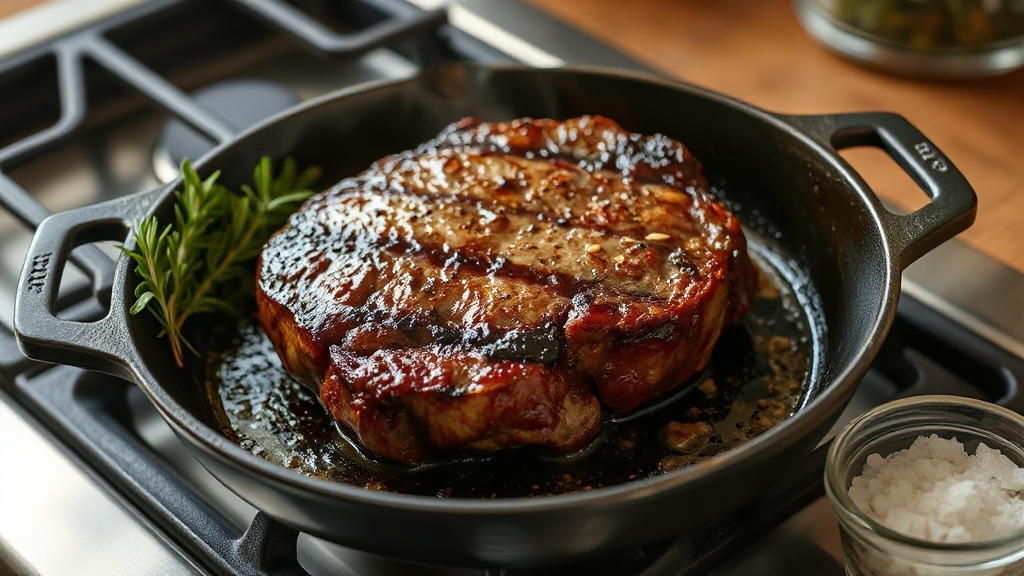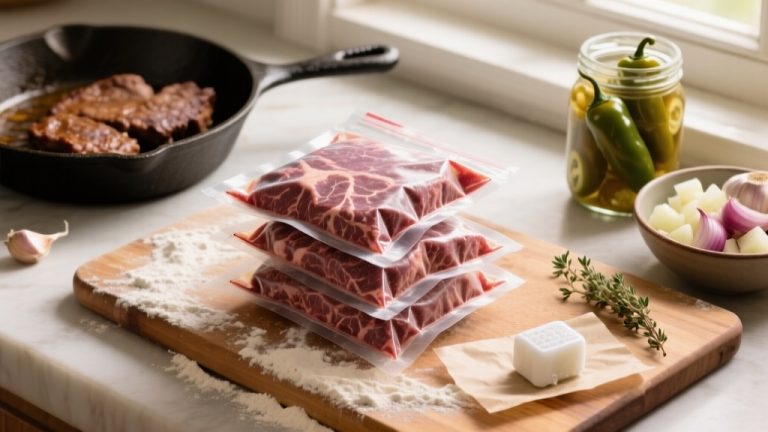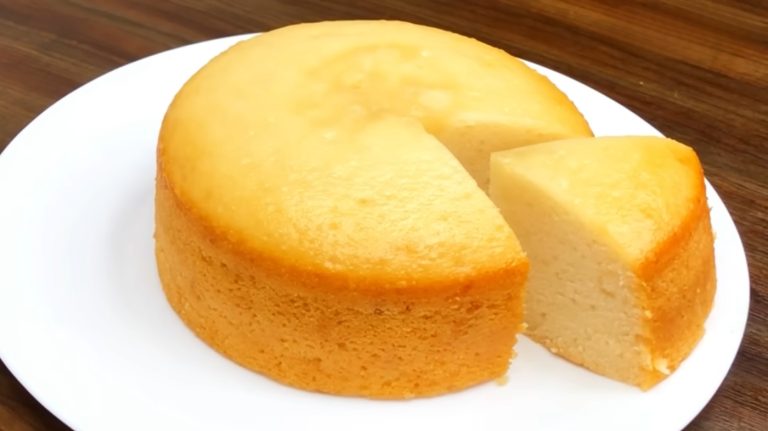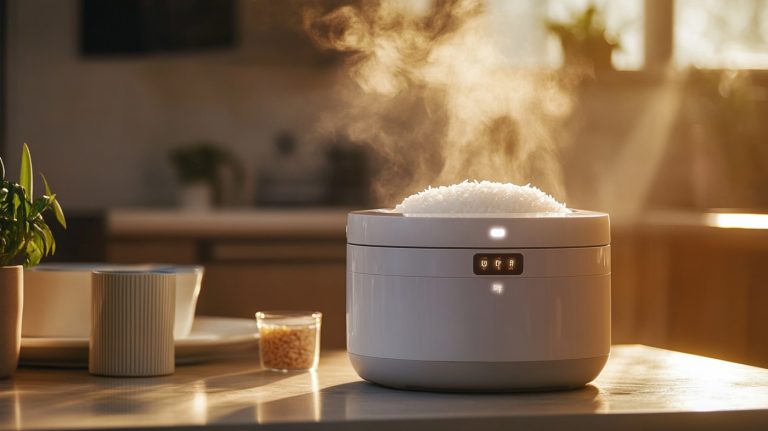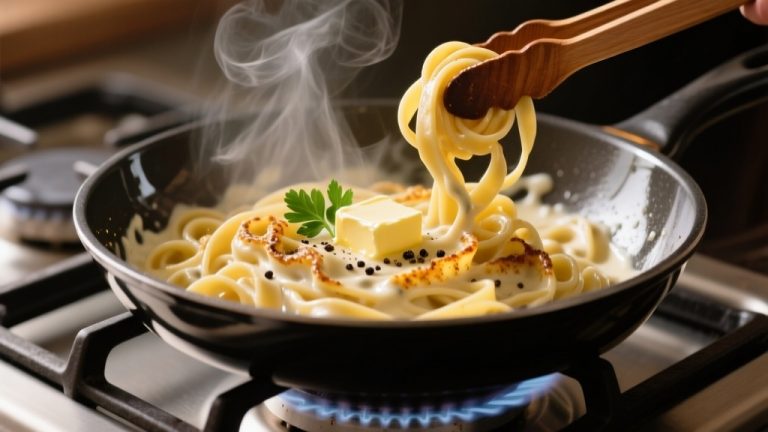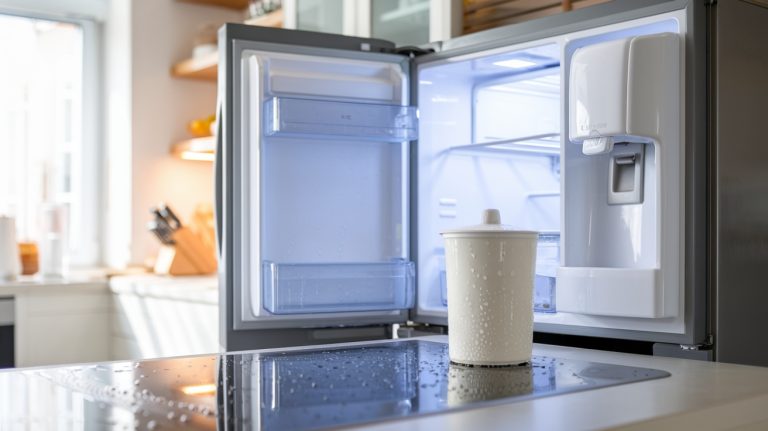How to Cook Baseball Steak? Tips for Juicy, Bold Flavor
To cook baseball steak, bring it to room temperature and pat it dry. Season generously with salt and a light touch of pepper.
Preheat your grill, pan, or broiler to high heat. Sear the steak for 2–4 minutes per side to develop a caramelized crust, then finish cooking to your preferred doneness using indirect heat or lower temperature.
Let it rest before slicing to retain juices. Keep exploring different methods and tips to perfect your steak every time.
Key Takeaways
- Preheat grill or skillet to high heat (about 550°F) for optimal searing and crust formation on the baseball steak.
- Season the steak generously with salt and pepper after bringing it to room temperature for even cooking.
- Sear the steak 2-4 minutes per side without flipping often, then move to indirect heat if needed for desired doneness.
- Use a meat thermometer to monitor internal temperature: medium-rare is 130-135°F, and let rest 5-10 minutes before serving.
- Enhance flavor by basting with herb-garlic butter during the last minute of cooking and garnish with fresh herbs.
Understanding Baseball Steak Cuts
A baseball steak comes from the center-cut top sirloin, prized for its thick, round shape that resembles a baseball. You’ll notice it’s typically cut to about ½ to 1 inch thick, making it tall and visually striking on your plate.
Because it’s taken from the larger muscle of the top sirloin, this steak is lean yet tender, offering a rich, beefy flavor similar to filet mignon. Its low fat content contributes to its tenderness without excess grease.
This cut is often sold in packages that include 2 steaks weighing approximately 1lb total, making it a convenient option for meals. package includes 2 steaks
When cooking, this thickness allows for even heat distribution, letting you choose various methods like grilling or pan-searing with confidence.
You’ll find baseball steaks commonly labeled as top sirloin or baseball cut at stores and restaurants, prized for their balance of flavor and leanness.
Choosing the Best Baseball Steak
Selecting the best baseball steak involves evaluating several key factors that impact flavor, tenderness, and overall quality. To choose wisely, focus on these essentials:
- Beef Quality and Source – Opt for high-grade USDA Prime or Choice, preferably local and sustainably raised, balancing freshness and ethical sourcing.
- Appearance – Look for a rich red color with slight pink hues, firm texture, and minimal marbling to enhance flavor without excess fat.
- Tenderness Indicators – Press the steak gently; it should spring back quickly. A fine grain structure signals tenderness.
- Flavor Profile – Consider dry-aged options for intensified beefy taste; avoid overpowering marinades to preserve natural flavor. The baseball steak is taken from the gluteus medius muscle, known for its lean and flavorful qualities.
Preparing Baseball Steak for Cooking
Once you’ve chosen the best baseball steak, proper preparation sets the stage for an outstanding cook. Start by thawing your steak safely—use a leak-proof bag and thaw in the refrigerator at 40°F or below for 24 hours per pound, or opt for cold water thawing for quicker results, about 30 minutes per inch of thickness.
When handling raw meat, wear gloves and clean all surfaces thoroughly to avoid contamination. Pat the steak dry with paper towels to promote better browning, then let it sit at room temperature for 30 minutes before cooking.
Prepare your tools: use sharp knives and dedicated cutting boards. Depending on your cooking method—oven, grill, pan sear, reverse sear, or smoking—ensure equipment is preheated properly to optimize heat retention and cooking control.
The baseball steak is typically at least two inches thick, which influences your cooking time and method choice.
Seasoning Techniques for Baseball Steak
Below are essential tips to elevate flavor and make every bite unforgettable.
Classic Salt Pepper
Two key ingredients define the classic salt and pepper seasoning for baseball steak: coarse salt and freshly ground black pepper. These enhance the steak’s rich flavor without overpowering it.
Before seasoning, brush the steak lightly with olive oil to help the spices adhere and promote a perfect crust. Season both sides generously just before cooking to avoid drawing out moisture. The baseball steak is known for its juicy interior and rich beefy flavor, making the choice of seasoning especially important.
Here’s how to nail the classic seasoning:
- Pat the steak dry to guarantee better browning.
- Brush with olive oil evenly on all sides.
- Sprinkle coarse salt liberally, followed by freshly ground black pepper.
- Season only right before grilling to keep the crust crisp.
Herb Marinades
While classic salt and pepper seasoning highlights the steak’s natural flavor, herb marinades offer a way to introduce layered taste and tenderize the meat.
To craft your marinade, combine olive oil, soy sauce, Worcestershire sauce, lemon juice, and minced garlic. Add dried basil, oregano, parsley, and sage for herbal depth, and use black or lemon pepper to enhance aroma.
Apply the marinade evenly to both sides of the steak, ensuring full coverage. Marinate between 2 and 24 hours depending on your time and desired tenderness.
The acid in lemon juice breaks down muscle fibers, while olive oil locks in moisture. Marinating helps tenderize the meat, which is especially beneficial for budget-friendly cuts.
This balanced marinade suits grilling, broiling, sautéing, or pan-searing, enriching flavor and aroma while maintaining juiciness. Use a rub to improve seasoning adherence for best results.
Grilling Baseball Steak Perfectly
Although grilling a baseball steak might seem straightforward, achieving the perfect sear and juicy interior requires careful preparation and temperature control. The baseball steak is cut in-house from the center of the Top Sirloin Butt, which gives it its distinctive thick round shape and rich flavor.
Start by patting the steak dry and letting it rest at room temperature for 30 minutes. Preheat your grill to medium-high (about 550°F) and clean, oil the grates.
Follow these steps for flawless grilling:
- Sear the steak over direct high heat for 2–4 minutes per side without flipping repeatedly.
- Move the steak to a cooler zone if it needs more cooking after searing.
- Baste with herb-garlic butter during the last minute on the grill for added flavor.
- Use a thermometer to remove the steak at 130–135°F for medium-rare doneness.
Pan-Searing Baseball Steak Tips
Start by patting your baseball steak dry and seasoning it generously to guarantee a flavorful crust. Allowing the steak to rest at room temperature for 40 minutes before cooking can enhance flavor penetration and searing quality resting time.
Heat a cast iron skillet until the oil just begins to smoke, then lay the steak in the pan without crowding. Sear each side undisturbed for 3–4 minutes to develop a perfect, caramelized crust.
Preparing the Steak
Before you heat your pan, make certain your baseball steak is at room temperature and thoroughly patted dry; this guarantees even cooking and helps develop a perfect crust.
Next, season your steak generously with sea or kosher salt to enhance flavor and texture, then add cracked black pepper lightly to avoid burning later.
If you prefer, apply a simple oil-herb coating, but avoid heavy marinades on thick cuts. Choosing the center cut top sirloin ensures a higher quality and more flavorful steak.
- Bring steak to room temperature for uniform cooking.
- Pat dry with paper towels to prevent steaming.
- Season generously with salt and lightly with pepper.
- Optionally, apply a light oil-herb marinade.
Achieving Perfect Sear
When you heat your pan correctly, you set the foundation for a perfect sear on your baseball steak. Use a cast iron or heavy pan, preheating it over medium-high heat until the oil just begins to smoke.
Add a drizzle of oil to coat the pan surface evenly. A well-seasoned cast iron skillet is ideal for achieving a good crust.
Place the steak in the pan and let it sear undisturbed for 3–4 minutes to develop a deep crust. Use tongs to check browning without piercing the meat.
Flip the steak once the first side is richly browned, then sear the second side for another 3–5 minutes. Add butter, garlic, and herbs after flipping to baste the steak. Adjust heat as needed, and consider finishing thick cuts in the oven for perfect doneness.
Broiling Baseball Steak Method
Although broiling baseball steak indoors differs from grilling, it delivers a similarly rich, caramelized crust by exposing the meat to intense radiant heat.
Start by positioning your oven rack 4-6 inches from the broiler and preheating it to about 550°F. Do not add butter or oil to the pan to avoid flare-ups and ensure even cooking.
Pat the steak dry, season generously, and place it on a foil-lined pan. Broil the steak for around 4 minutes per side, flipping carefully with tongs to retain juices.
Use a meat thermometer to check for medium-rare doneness at 120-125°F. After broiling, let your steak rest for 5 to 10 minutes to redistribute juices and enhance flavor.
- Preheat broiler and position rack correctly
- Season steaks and arrange evenly on pan
- Broil 4 minutes per side, flip gently
- Rest steak before slicing against the grain
Using Reverse Searing for Baseball Steak
Since reverse searing works best with thick-cut baseball steaks, you’ll want to start by seasoning your steak generously and letting it dry uncovered in the refrigerator overnight. This dries the surface, improving the sear later.
Bring the steak to room temperature before cooking. This step helps ensure more even cooking throughout the steak. Next, place it on a wire rack over a rimmed baking sheet and cook in a low oven set between 200 to 275°F (93 to 135°C). Use a thermometer to monitor internal temperature.
Once the steak reaches about 10 to 15°F below your target doneness, heat a cast-iron skillet with oil until smoking hot. Sear the steak about 45 seconds per side, adding butter and garlic before flipping for extra flavor and a crispy, browned crust.
Determining Doneness and Cooking Times
To cook your baseball steak perfectly, you need to monitor its internal temperature closely, aiming for specific degrees based on your preferred doneness.
Cooking times will vary with the steak’s thickness, so adjust your searing and roasting accordingly. Use an instant-read thermometer to get accurate readings quickly and avoid overcooking.
The 12oz Top Sirloin Baseball Steaks are Individually Vacuum-Packed to preserve their natural juices and ensure quality during cooking.
Internal Temperature Guide
How do you know when your baseball steak has reached the perfect doneness? The key is monitoring its internal temperature with a reliable meat thermometer. Here’s a quick guide:
- Rare: Remove at 120-130 °F for a cool, red center.
- Medium Rare: Pull at 130-135 °F for a warm, pink center.
- Medium: Aim for 135-145 °F for a firmer, light pink center.
- Well Done: Cook to 155-165 °F for no pink, fully cooked meat.
Always insert your thermometer into the steak’s thickest part. Steaks cook from the outside in, so it’s important to manage heat carefully to avoid overcooking the exterior while waiting for the inside to reach the desired temperature outside-in cooking.
Use medium-high heat for searing, then check temperatures to avoid overcooking. Let your steak rest 5-10 minutes after cooking to let juices redistribute. This precise temperature control guarantees a consistently delicious baseball steak every time.
Timing Per Thickness
Knowing the internal temperature is essential, but timing your baseball steak according to its thickness guarantees you hit that perfect doneness consistently.
For a 1.5-inch thick steak, plan on grilling about 4 minutes per side for medium-rare. Thicker cuts, like 2 inches, need 5 to 6 minutes per side.
Start with a high-heat sear to develop a flavorful crust, then finish cooking either on the grill or in the oven for even heat distribution. Using an accurate thermometer is the best way to ensure the steak reaches the desired doneness without guesswork, so be sure to insert it through the side of the thickest part, avoiding bone or fat for the most precise reading. accurate thermometer
Remember, baseball steaks are lean, so avoid overcooking to prevent dryness. Adjust timing based on your appliance’s heat output and environmental conditions.
Once cooked, let the steak rest for 5 to 10 minutes to allow juices to redistribute, ensuring a juicy, tender bite every time.
Using Instant Thermometer
An instant thermometer is your most reliable tool for achieving perfect doneness when cooking a baseball steak.
To use it effectively, insert the probe into the thickest part of the steak, avoiding bone and fat, and wait at least three seconds for a stable reading. Monitor the temperature early, removing the steak 5–10°F below your target to account for carryover cooking.
Here’s how to guarantee precision:
- Calibrate your thermometer regularly using ice or boiling water tests.
- Check multiple spots to confirm even cooking.
- Avoid touching pan or plate with the probe for accurate readings.
- Rest the steak 5–10 minutes after removing it to distribute heat evenly.
Serving Suggestions and Pairings
When you serve baseball steak, pairing it thoughtfully enhances both flavor and presentation. Complement your steak with loaded baked potatoes or triple-cooked wedges for a hearty starch. Chunky oven chips are a classic side dish that pairs perfectly with steak and add a satisfying crunch.
Add steamed asparagus or a crisp green salad with vinaigrette to balance richness. For sauces, try béarnaise, chimichurri, or compound butters to boost juiciness and depth.
Consider protein complements like fried eggs for breakfast or grilled shrimp for surf and turf. Beverage choices matter; full-bodied reds like Cabernet Sauvignon or a robust stout beer match perfectly.
Serve steaks hot off the grill with melting herb butter for visual appeal. Slice thinly for tacos or stroganoff, and garnish with fresh herbs or grilled lemon wedges to add brightness and contrast.
Frequently Asked Questions
Can Baseball Steak Be Frozen and Still Maintain Quality?
Yes, you can freeze baseball steak and still maintain quality if you do it right. Make sure to package it properly using airtight freezer bags to prevent moisture loss and freezer burn. Freeze it quickly at 0°F or below to preserve texture.
Thaw it safely in the fridge before cooking. Just remember, refreezing can reduce quality, so try to freeze in portions you’ll use at once.
How Long Can Cooked Baseball Steak Be Safely Refrigerated?
Think of your cooked baseball steak as a delicate treasure that thrives briefly in the cool vault of your refrigerator. You can safely store it for 3 to 4 days at temperatures below 40°F (4°C). To preserve its juicy essence, wrap it tightly or use airtight containers.
Don’t forget to refrigerate it within two hours of cooking to keep bacteria at bay, ensuring every bite remains safe and flavorful.
What Are the Best Knife Types for Slicing Baseball Steak?
For slicing baseball steak, you’ll want a long, sharp slicing knife or a carving knife with a smooth edge to guarantee clean cuts. A 12-inch blade works best for larger cuts, giving you control and precision. Avoid serrated edges, as they can tear the meat.
Look for ergonomic handles for comfort during slicing. Trusted brands like Victorinox and Wüsthof offer excellent options that combine sharpness, durability, and ease of use.
Can Baseball Steak Be Used in Recipes Other Than Grilling or Searing?
You don’t have to worship the grill like it’s the steak’s only altar. You can toss baseball steak in an oven, slow cooker, or even a pressure cooker—each method coaxing different textures and flavors. Slice it thin for salads or stir-fries, dice it for tacos, or marinate it for a Korean BBQ twist.
Are There Specific Wine Pairings for Different Baseball Steak Cooking Levels?
Yes, you should match wine to your baseball steak’s cooking level. For rare, choose bold reds like Cabernet Sauvignon to complement its juicy texture. Medium-cooked steak pairs well with versatile wines such as Malbec or Zinfandel, enhancing smoky flavors.
When cooked medium-well or well-done, opt for wines with softer tannins and higher acidity to balance drier meat, like Pinot Noir or Sangiovese. Adjust based on your steak’s seasoning and sauce for the best match.
Cook Baseball Steak Like a Pro and Serve a Home Run Every Time
Now that you’ve mastered the art of cooking baseball steak, you’re well on your way to impressing at any meal. With the right cut, seasoning, and technique—whether grilling, broiling, or reverse searing—you’ll consistently deliver a steak that’s nothing short of a home run.
Remember, patience is your ally in achieving that perfect doneness. Serve it up with confidence, and enjoy the subtle applause from satisfied palates around your table.

